Sea Boots Charters: Pier 5 to Summerland Key
The story of a historic fishing charter business that spans 85 years, 135 miles, and two families from Miami's world famous Pier 5 to Summerland Key in the Florida Keys.
Bayside Marketplace in downtown Miami, the former site of the world-famous Pier 5, and Summerland Key are separated by 135 miles. Given the distance, one would think the two locations would have very little in common. However, the two places have a tie to one of South Florida’s legendary fishing ventures, the historic Sea Boots Charters.
Dating back to the early years of Pier 5, the fishing charter business was a family enterprise that conveyed the passion for deep sea fishing from one generation to the next. This was true of the founding of Sea Boots Charters when Buddy Carey decided to hang his shingle at Pier 5 in downtown Miami. While the connection to the same business in Summerland Key does not share bloodlines, it does share a mutual connection based on years of history between two families. This is the story of how a mutual passion for fishing and family ties have kept the Sea Boots brand alive for more than eighty-five years.
Founding of Pier 5
At the time the City of Miami acquired the riparian rights from the Florida East Coast company in the mid-1920s, the shoreline along Biscayne Bay in downtown Miami was primarily used by the company for private dockages. The city purchased the rights to create land from the shoreline into Biscayne Bay, aka riparian rights, to form Bayfront Park.
Once the park was created from bay bottom fill, the city constructed a series of piers along the shoreline, adjacent and to the north of the newly created park. Piers 1 – 4 were primarily used by the Port of Miami for cargo transport and commercial shipping, but the municipality designated Pier 5 as a dock for sightseeing vessels, private moorage, and commercial charter enterprises offering fishing excursions for locals and tourists. Although the city referred to this last dock as the ‘City Yacht Basin’ initially, and later as just the ‘City Docks’, many early Miami residents and visitors referred to it as the world famous ‘Pier 5.’
The City Yacht Basin officially opened for business in the spring of 1925 and became an immediate tourist destination in downtown Miami. Some visitors showed up to see the large yachts moored in Pier 5, others were hoping to charter one of the many fishing vessels that conducted business out of the new marina. Given the excitement over the opening of the new city docks and the subsequent popularity of this new waterfront venue, members of the Miami Boatman’s Association began to lease slips to run their fishing charter operations out of this new wharf.
Buddy Carey & Sea Boots Charter
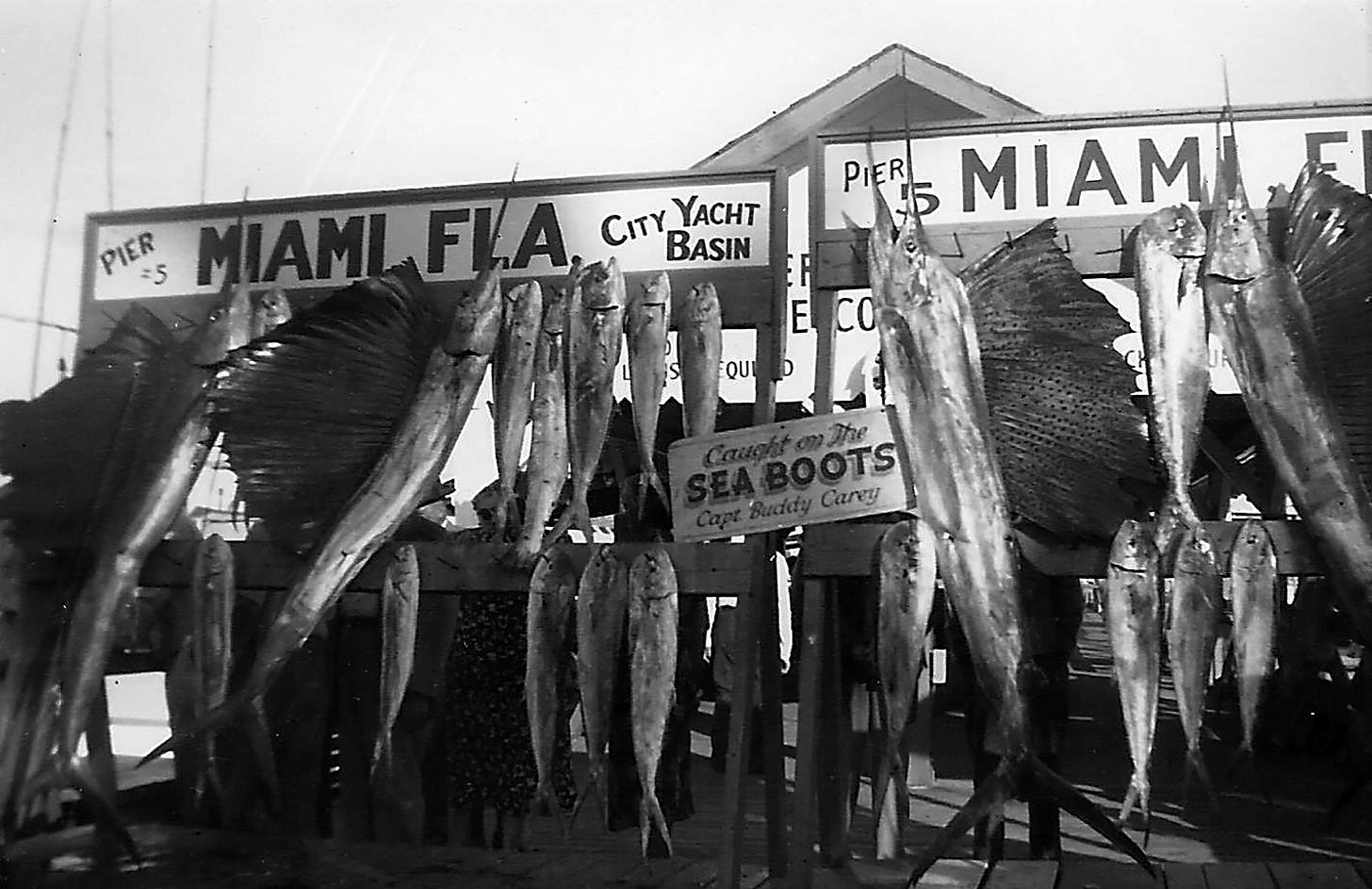
According to his profile page on the International Game Fish Association website, Buddy Carey “began his sport fishing career at the age of 13 working with his dad, Captain Oliver Carey, on the family’s Miami charter boat.” Captain Oliver Carey operated the Sea Hawk charter out of Pier 5 from 1929 to 1935.
While Buddy learned his craft while working for his father, he also worked for other charters out of Pier 5. In 1935, he was a mate on Captain Wilford Underwood’s Music Made fishing vessel, and was mentioned in the Miami Herald on June 23, 1937, as a guide on a boat called Solandra.
By the end of 1937, Buddy purchased his first boat which he named Sea Boots, a vessel that he owned for 13 years and operated out of Pier 5. He said it looked like a big dingy which “had a displacement-type hull and would only do 10 miles an hour.” His mate during the early days was Jimmie Albury, who later became well known as the skipper of the Falcon out of Bimini.
Beginning in 1938, newspapers regularly reported on the catch brought back by Captain Buddy Carey and the Sea Boots crew. From that point forward, Carey was not only a staple at Pier 5 in downtown Miami, but he became a legendary figure in the charter fishing business in South Florida.
Although it is unknown how Buddy came to name his first vessel Sea Boots, there were references to a large vessel that docked in Miami in the 1920s with the same name. While it was sometimes referred to as a yacht, and other times as a fishing cruiser, the original incarnation of the Sea Boots name was operated by Captain Bill Fagen. In an article published in January of 1929 in the Miami Daily News, there was also a reference to a smaller fishing vessel called the ‘Sea Boots Junior’ which was part of the fleet of fishing boats coordinated by Captain Fagen.
Service in Coast Guard During WWII

At the onset of America’s participation in World War II, Buddy joined the Coast Guard and was assigned to a retrofit yacht turned military cruiser called the Black Swan. In addition to patrolling the Florida coast around South Florida, the primary responsibility of the crew assigned to the Black Swan was to monitor the lighthouses and ensure that the light fixtures were operational. A working lighthouse was key in helping the Navy’s surveillance blimps spot German U-boats in the coastal waters.
It was during Carey’s assignment on the Black Swan that he met Captain Tommy Gifford, who was a charter boat captain primarily operating around Ocean Reef prior to the war, and Captain James Sharpe Sr., who was a captain with the Miami Fire Department, and fisherman during his time off. Gifford may best be remembered as the inventor of the outrigger which allowed fishing lines to project further from a boat.
In addition to patrolling the coastline around Miami and the Florida Keys, the Black Swan would venture as far as the Dry Tortugas to inspect lighthouses. The Coast Guard commandeered the Royal Palm Club, which operated out of a building constructed by the Biscayne Bay Yacht Club at the southern tip of Bayfront Park, for its headquarters during the war.
During their service together, Carey, Gifford and Sharpe formed a lifelong friendship and bonded over their interest in deep sea fishing. Once the war ended, Captain Sharpe Sr. was instrumental in forming the Fireman’s Benevolent fishing camp on Key Largo, located just north of where Snook’s Bayside Restaurant is located today. During his time off, Sharpe Sr. and others constructed a fleet of 16-foot small plywood fishing boats behind the fire station located on Flagler Street which were deployed to the fishing camp in Key Largo for fireman to enjoy while they were off duty. Time spent at this camp provided early fond memories for Sharpe’s five-year-old son who would inherit his father’s passion for salt water fishing.
A Father’s Legacy

James Sharpe Sr., who found his calling as a firefighter during the formative years of the City of Miami, went to work at Fire Station #1 in downtown Miami in the 1910s. He applied to work at Miami’s downtown station because he wanted to stay busy at an active station. Most of the calls to extinguish fires took place on the north side of the Miami River and James Sr. found himself at the right station for his temperament.
In the early 1920s, after being elected the first union president for the fire department, Sharpe Sr. fell out of favor with the chief of the department, Milton Bullock, who promptly reassigned him to Southside fire station number 4, which was located in today’s Brickell neighborhood. The Southside station had very few calls and was not busy, and Bullock knew it would drive Sharpe crazy and may force him to leave the department.
Rather than quit, James Sharpe Sr. used the slow time to study for the exams to allow him to earn the rank of captain within the fire department. Around the same time, James Sharpe Jr. became a captain of his own personal fishing vessel which allowed him to enjoy his favorite pastime. The senior Sharpe took his son, James Sharpe Jr., out fishing as often as possible, which allowed father and son to bond over their mutual passion for dropping a line and catching fish in the open waters around Miami and the Florida Keys.
In 1958, given the enthusiasm he inherited from his father for the ocean and deep sea fishing, James Sharpe Jr. took a part-time job at Everett’s Marine Service at 55 SW Miami Avenue at the age of 16. One of his fondest memories as an attendant was when Gar Wood pulled into the service marina for gas in one of his speedsters. He remembered hearing Wood’s speedboat navigate down the Miami River long before he saw him.
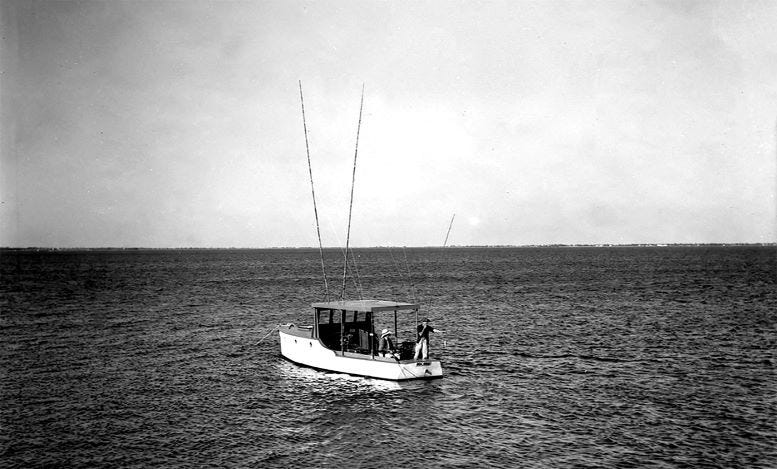
In 1960, the year he lost his father to a heart attack, James Jr. got a job working at Pier 5 as a first mate on a charter boat owned by the infamous Red Rainwater, who was omnipresent at the historic pier, having leased dock space for his fleet of fishing vessels beginning the first year of Pier Five in 1925. Rainwater was a rum runner during Prohibition, and later became the collector of protection money from Bolita operators for Miami’s vice squad during the middle decades of the twentieth century. Although James Jr. did not work with Rainwater directly, he once got a glimpse of a trunk full of cash when Red asked him to help carry some fishing equipment to the dock.
Sharpe did work directly with one of Rainwater’s captains, Fred Harvey, who operated the Papa Seagull out of Pier 5 in a slip adjacent to Buddy Carey’s Sea Boots fishing cruiser. James Jr. got reacquainted with his father’s friend and remained on cordial terms with the Pier 5 legend from that point forward.
James Jr. would continue to learn the fishing business while working for John Sacon at Haulover Beach in 1963. A year later, in 1964, he went to work for the North Miami Fire Department as a paramedic, which was later shifted to the county as part of Metro-Dade movement in the late 1960s. Sharpe helped outfit and organize the trucks as part of the transition from a city to a county-wide service.
In 1969, Sharpe was stationed in Kendall with Metro Dade working a schedule of 24-hours on duty and 48-hours off-duty. By the mid-1970s, Captain Jim Sharpe Jr. decided to build a house on Cudjoe Key and started operating a fishing charter business out of Summerland Key while off duty with the fire department. Prior to officially launching his operation, he approached Captain Buddy Carey and asked if he could use the ‘Sea Boots’ name for his boat and business in the Keys. Carey never trademarked the moniker and was happy to give Sharpe consent to use the name.
End of an Era in Miami
For decades Captain Buddy Carey endured the constant changes of Pier 5 while providing his paying passengers with a great experience on the open seas. Enduring hurricanes, unfavorable winds and tides, and structural changes at the municipal owned docks, were some of the many hurdles Buddy had to overcome as a charter captain operating out of the city docks. On two different occasions, Buddy, along with all those who leased a slip at Pier 5, had to relocate and operate from Watson Island while the docks were redeveloped.
The transformation of Pier 5 to Miamarina, which opened in 1970, as well as the development of Bayside in the mid-1980s, required the temporary relocation of all fishing charter businesses to Watson Island. Despite the inconveniences and rough conditions associated with Watson Island, Miami’s Sea Boots Charters endured and thrived until Buddy’s retirement from the fishing business in the late 1980s.
During the 1970s, the Carey family had two boats that carried the Sea Boots name. One was a $50,000 custom-made boat that was operated by Buddy’s son, Mike, and the other a 48-foot Alligood which was run by Buddy. When asked by Miami Herald journalist Jim Hardie to share his secret to fishing success, published on March 4, 1970, Buddy replied:
“There’s no secret. We try to keep our equipment in good shape, and we go out when some of the others choose to stay in.”

In addition to hiring a fishing guide or boarding a sightseeing vessel, Pier 5 was famous for the crowds that gathered by the docks to check out the catch of the day and possibly purchase fish from the return charters. When Sea Boots returned to the docks after a full day of fishing, there was always a crowd of gawkers as the catch was hung for inspection by the anglers who hired Buddy and his crew that day. In one instance, while fileting fish on his dock at Pier 5, a woman approached him and asked if “those fish were fresh?” Buddy fought back the urge to provide a sarcastic remark and replied that “the fish were fresh and a good buy at $1.50 a pound, filleted and ready for the oven.” These types of interactions were common at Pier 5 where fresh fish were sold to the public as quickly as it they were filleted on the dock.
In 1987, Captain Buddy Carey was honored at the Miami Rod and Reel Club at a time when his Sea Boots charter had been running out of Pier 5 in downtown Miami for 51 years. Buddy had long been considered the “Dean of Pier 5,” and as he was approaching retirement, he was able to share his stories, knowledge, and wisdom with the next generation of anglers.
Sea Boots in Summerland Key
After transitioning his family to the Florida Keys in the mid-1970s, Captain James Sharpe Jr. began operating Sea Boots Charter out of Summerland Key in between shifts at the fire department. He would sometimes leave Kendall in the morning after a 24-hour shift only to drive down to the Keys to meet a charter at his dock on Summerland Key. He continued this routine for nearly 20 years prior to his retirement from the county in 1993.
During his time running his charter business, Captain James Sharpe Jr. built a reputation and a brand that was synonymous with the lower keys. He wrote a book called ‘Dolphin: The Perfect Gamefish,’ and was host to a television show called ‘The Florida Keys Fishing Report’ on Channel 5, the public broadcasting station, for ten years, from 1977 to 1987. He moved onto radio in 1987 as the host of a show with the same name on US 1, 104.1FM, which still broadcasts to this day.
Although Sea Boots Charter has thrived out of Summerland Key for fifty years, it has endured its share of hardship. Over the course that fifty years, economic cycles, hurricanes, and the usual maintenance issues with operating a 34-foot vessel on the high seas have created obstacles to running a fishing charter business. One of the most notable challenges was when Hurricane Irma hit the lower Keys in 2017. The vessel that faithfully served Sea Boots charter for more than twenty-five years, a boat constructed by Sharpe himself, sunk in the channel where it was moored during the destructive hurricane. Fortunately, Captain Sharpe Jr. was able to replace the twenty-seven-year-old vessel as part of an insurance claim.
The replacement cruiser is a 35-foot Sea Hunter with three 300 HP Yamaha engines that can reach a top speed of 65 and a cruise speed of 45 miles per hour. The vessel is able to reach the deep waters found 30 miles offshore in less than 30 minutes.
While most would have sailed off into retirement after pouring 50 years of service into one profession, Captain Jim Sharpe Jr. is still following his passion by taking charters out for unforgettable fishing experiences on the deep seas of the lower keys. For those who are seeking an authentic experience fishing in the Florida Keys, one can still book the historic Sea Boots Charter, operated by a captain with more than 50 years of experience in the Florida Keys, by contacting them at (305) 745-1530.
Resources:
Interview: Captain James Sharpe Jr. in April of 2025.
Miami Herald: “Yacht is Sent North Aboard Munson Liner”, April 14, 1928.
Miami Daily News: “Doesn’t Happen Every Day”, December 6, 1941.
Miami Daily News: “Fishing Prospects Up in the Air”, November 5, 1965.
Miami Herald: “Buddy Carey’s Sea Boots Become a Fishing Landmark”, by Jim Hardie on March 4, 1970.
Miami News: “All is not Hardy for Charter Boats”, by Ian Glass on February 20, 1971.
Miami News: “No, they’re not fresh fish; They are well-mannered”, by Jeff Klinkenberg on November 7, 1974.
Miami Herald: “Bay Captains up the Creek Minus a Dock”, March 14, 1985.
Miami Herald: “Fisherman, charter captains unhappy at Watson Island”, April 13, 1986.
Miami Herald: “Captain Buddy Carey to be Honored”, August 23, 1987.
Miami Herald: “Paramedic Heals Psyche at Sea”, November 26, 1990.


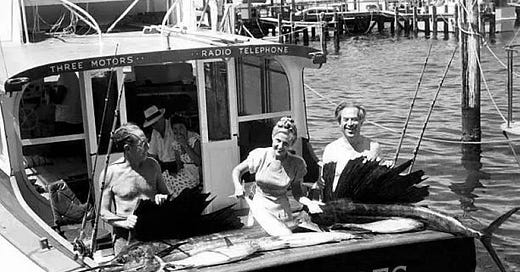



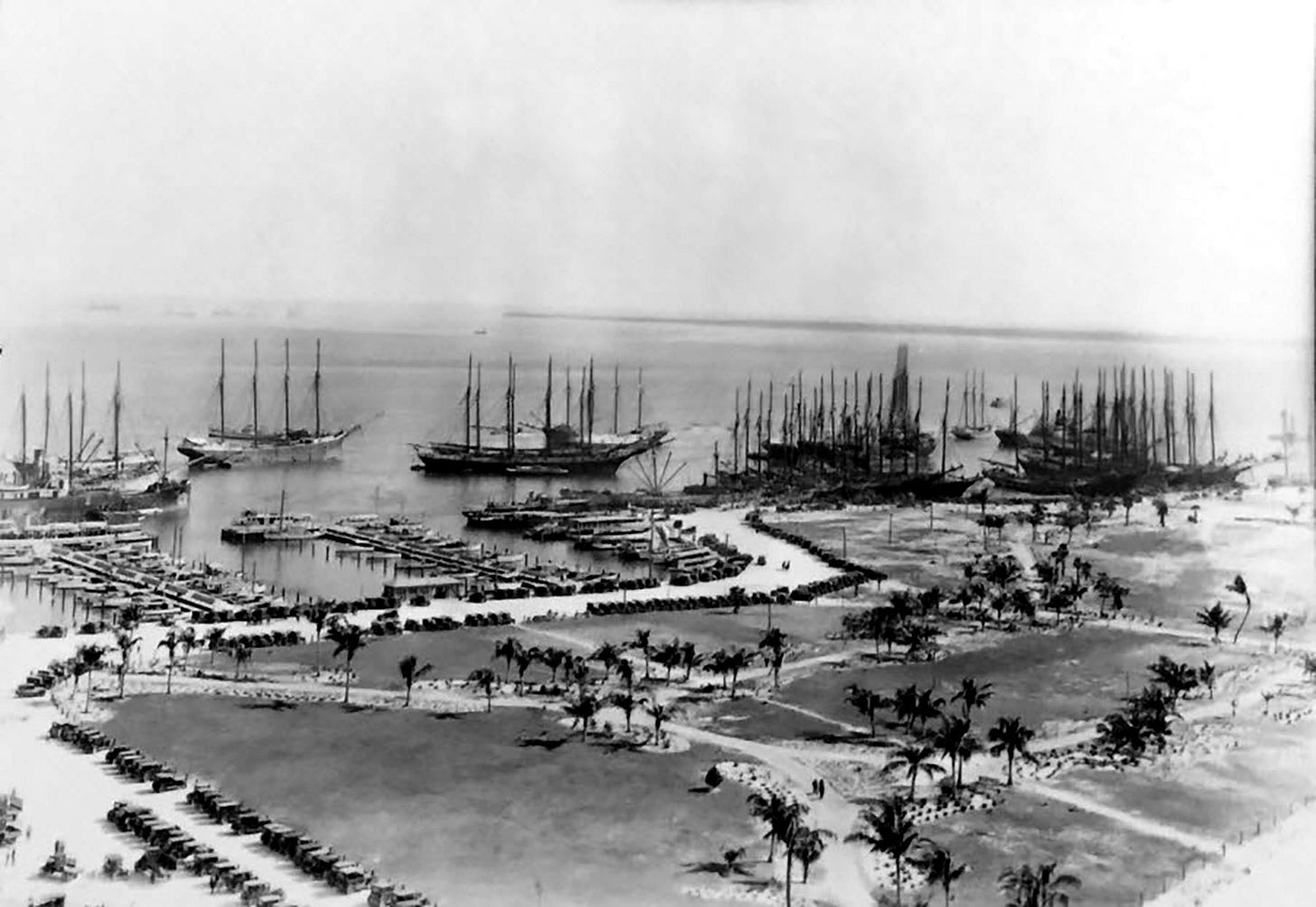
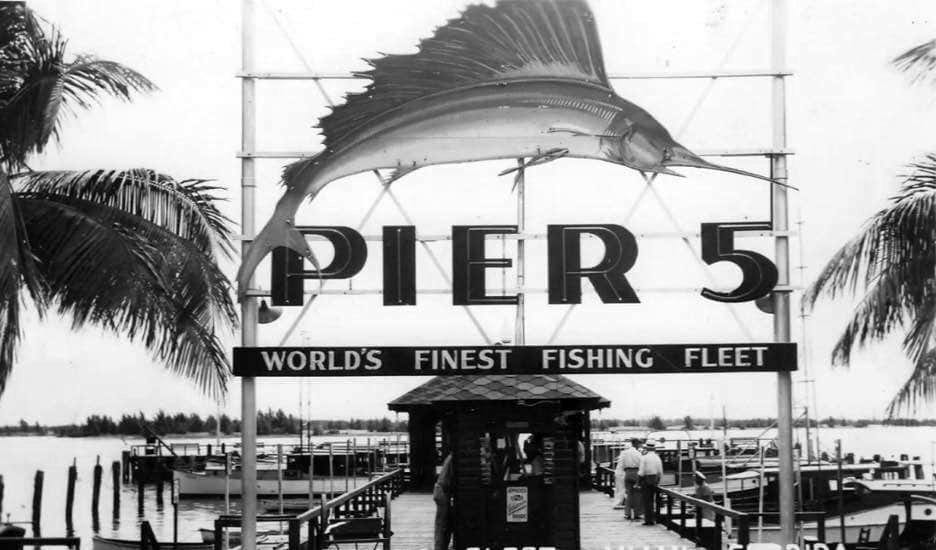
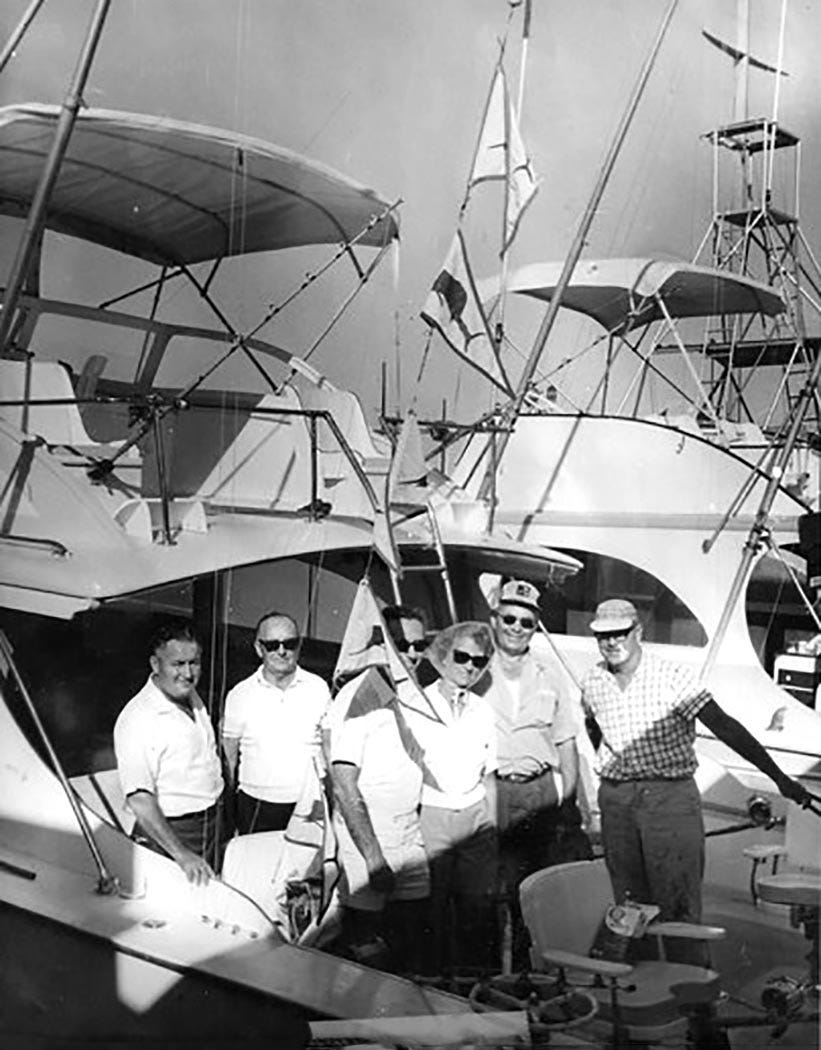
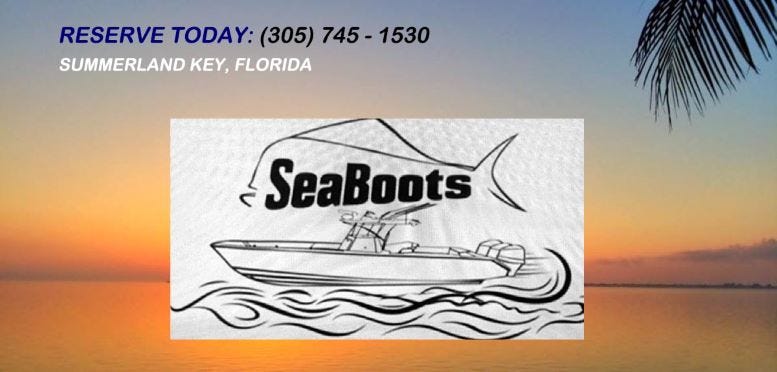
Thank you very much for the detailed article about Pier 5. When I was a little girl in the 1940’s my father often took me to Bayfront Park to feed the pigeons, then we would visit Pier 5 and watch the fishing boats come in….always interesting……good memories. Laramie Adams Gilder